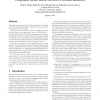Free Online Productivity Tools
i2Speak
i2Symbol
i2OCR
iTex2Img
iWeb2Print
iWeb2Shot
i2Type
iPdf2Split
iPdf2Merge
i2Bopomofo
i2Arabic
i2Style
i2Image
i2PDF
iLatex2Rtf
Sci2ools
MOBICOM
1997
ACM
1997
ACM
Composable ad-hoc Mobile Services for Universal Interaction
This paperintroduces the notion of “universalinteraction,” allowing a device to adapt its functionality to exploit services it discovers as it moves into a new environment. Users wish to invoke services — such as controlling the lights, printing locally, or reconfiguring the location of DNS servers — from their mobile devices. But a priori standardizationof interfaces and methods forservice invocation is infeasible. Thus,the challenge is to develop a new service architecture that supports heterogeneity in client devices and controlled objects, and which makes minimal assumptions about standard interfaces and control protocols. There are five components to a comprehensive solution to this problem: 1) allowing device mobility, 2) augmenting controllable objects to makethem network-accessible, 3) building an underlying discovery architecture, 4) mapping between exported object interfaces and client device controls, and 5) building complex behaviors from underlying composable ob...
Client Device | Communications | Methods Forservice Invocation | MOBICOM 1997 | Priori Standardizationof Interfaces |
| Added | 06 Aug 2010 |
| Updated | 06 Aug 2010 |
| Type | Conference |
| Year | 1997 |
| Where | MOBICOM |
| Authors | Todd D. Hodes, Randy H. Katz, Edouard Servan-Schreiber, Lawrence A. Rowe |
Comments (0)

